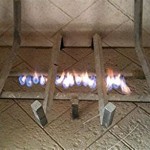Cover Fireplace Opening: A Comprehensive Guide
Covering a fireplace opening, whether for aesthetic reasons, energy efficiency, or safety, is a common practice in many homes. The process and materials used can vary significantly depending on individual needs and preferences, ranging from simple temporary solutions to permanent structural alterations. This article will explore the different approaches to covering a fireplace opening, examining the considerations, techniques, and materials involved in each scenario.
A fireplace, traditionally a source of heat and ambiance, can become a source of energy loss when not in use. The open flue allows warm air to escape during the winter and cool air to escape during the summer, leading to increased energy bills. Furthermore, unattended fireplaces can present safety hazards, especially for families with young children or pets. Thus, understanding how to effectively cover a fireplace opening is crucial for maintaining a comfortable and safe home environment.
Energy Efficiency Considerations
One of the primary motivations for covering a fireplace opening is to improve energy efficiency. An open fireplace flue acts as a chimney, constantly drawing air from the house and expelling it outside. This creates a negative pressure, which forces the heating or cooling system to work harder to maintain the desired temperature. Properly sealing or covering the opening can significantly reduce this energy loss.
Several options are available for improving energy efficiency. Fireplace dampers, designed to close off the flue, are a common feature in many fireplaces. However, older dampers may not seal completely, allowing some air leakage. Upgrading to a more efficient damper, such as a top-sealing damper installed at the top of the chimney, can improve the seal and minimize air loss. These dampers often incorporate a rubber gasket or similar material to create a tighter seal than traditional throat dampers.
Another approach is to use a fireplace plug or pillow. These inflatable or foam-based devices are designed to be inserted into the flue and expanded to create a tight seal. Fireplace plugs are relatively inexpensive and easy to install, making them a popular option for homeowners looking for a quick and effective solution. However, it is crucial to remember to remove the plug before lighting a fire to prevent dangerous carbon monoxide buildup.
For a more permanent solution, consider sealing the fireplace opening with insulation. Rigid foam insulation board can be cut to size and inserted into the opening, creating a barrier against air leakage. The edges of the insulation board can be sealed with caulk or foam sealant to further improve the effectiveness of the seal. This approach is particularly suitable for fireplaces that are no longer in use or are rarely used. It is essential to use fire-resistant materials and adhere to local building codes when undertaking this type of insulation project.
Finally, installing a glass fireplace door can also contribute to energy efficiency. While not a complete seal, a well-fitted glass door can reduce the amount of air flowing through the fireplace opening, minimizing heat loss when the fireplace is not in use. Glass doors also provide an additional safety barrier, preventing sparks and embers from escaping into the room.
Aesthetic and Decorative Solutions
Beyond energy efficiency, covering a fireplace opening can also serve aesthetic and decorative purposes. An unused fireplace can be perceived as an eyesore, particularly if it is in a prominent location in the room. Covering the opening can transform the fireplace into a decorative feature, enhancing the overall appearance of the space.
One simple solution is to use a decorative fireplace screen. Fireplace screens come in a wide variety of styles, materials, and finishes, allowing homeowners to choose a screen that complements their existing décor. Screens can be made of metal, glass, wood, or a combination of materials, and they can feature intricate designs or simple, minimalist patterns. A fireplace screen can effectively conceal the dark and empty opening of the fireplace, creating a more visually appealing focal point in the room.
Another option is to create a decorative display within the fireplace opening. This can involve arranging candles of varying sizes and shapes, placing a collection of decorative objects or plants, or even creating a small art installation. The key is to choose items that are visually appealing and that complement the style of the room. When using candles, it is important to ensure that they are placed on a non-flammable surface and that they are not left unattended.
For a more permanent solution, consider installing a custom-built cover for the fireplace opening. This can be made of wood, metal, or other materials and can be designed to match the style of the fireplace surround. A custom-built cover can effectively conceal the opening while also adding a unique decorative element to the room. It is important to consult with a professional contractor or carpenter to ensure that the cover is properly installed and that it complies with all relevant building codes.
Repurposing the fireplace opening is another creative approach. This might involve converting the space into a bookcase, a storage niche, or even a small display area. By adding shelves or other structural elements, the fireplace opening can be transformed into a functional and aesthetically pleasing feature. This approach requires careful planning and execution, but it can result in a truly unique and personalized addition to the home.
Safety and Preventative Measures
Covering a fireplace opening can also be a proactive measure to enhance safety, particularly in homes with young children or pets. An open fireplace presents potential hazards, such as the risk of falling into the firebox or coming into contact with sharp edges or debris. By covering the opening, these risks can be significantly reduced.
Installing a child safety gate or barrier around the fireplace is a simple and effective way to prevent children from accessing the firebox. These gates are typically made of metal or plastic and can be easily installed and removed as needed. Child safety gates provide a physical barrier that prevents children from getting too close to the fireplace, minimizing the risk of accidents.
Using a fireplace screen can also provide a safety barrier, preventing sparks and embers from escaping into the room. This is particularly important when using a wood-burning fireplace, as sparks can ignite nearby flammable materials, such as carpets or furniture. A well-constructed fireplace screen can effectively contain sparks and embers, reducing the risk of fire.
When covering a fireplace opening for safety reasons, it is important to choose materials that are non-toxic and fire-resistant. Avoid using materials that could pose a choking hazard or that could emit harmful fumes if exposed to heat. Ensure that any covering or barrier is securely installed and that it cannot be easily removed by children or pets.
Regularly inspecting and cleaning the fireplace is also crucial for maintaining a safe environment. Remove any accumulated debris or soot from the firebox and chimney, and ensure that the damper is functioning properly. A clean and well-maintained fireplace is less likely to pose a safety hazard. Furthermore, having a qualified professional inspect the chimney annually is crucial for detecting any potential structural issues or blockages that could lead to carbon monoxide buildup or chimney fires.
In addition to physical barriers, consider installing a carbon monoxide detector in the vicinity of the fireplace. Carbon monoxide is a colorless, odorless gas that can be deadly. A carbon monoxide detector will alert you to the presence of this gas, allowing you to take prompt action to protect yourself and your family. Ensure that the detector is functioning properly and that it is tested regularly.
Properly covering the opening while also focusing on regular maintenance will enhance safety. This includes regular cleaning and inspection to help mitigate potential risks associated with unused or underutilized fireplaces. By taking these preventative measures, homeowners can create a safer and more comfortable living environment for themselves and their families.

Fireplace Cover Screen Insert Split Wood De

Easy Diy Fireplace Cover Sarah Joy

17 Unused Fireplace Cover Ideas Diy

Wooden Fireplace Cover Diy And Mantel Bless This Nest

Diy Fireplace Cover Tutorial Ehow

How To Make A Diy Rust Fireplace Cover Salvaged Living

Easy Diy Fireplace Cover Board Screen Celebrated Nest

How I Created An Insulated Fireplace Cover With Pallet Wood Diy Doors

10 Creative Ideas To Cover Your Fireplace Opening

Easy Diy Fireplace Cover Sarah Joy
Related Posts








